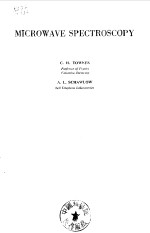图书介绍
MICROWAVE SPECTROSCOPYPDF|Epub|txt|kindle电子书版本下载

- C.H.IOWNES A.L.SCHAWLOW 著
- 出版社:
- ISBN:
- 出版时间:未知
- 标注页数:698页
- 文件大小:28MB
- 文件页数:703页
- 主题词:
PDF下载
下载说明
MICROWAVE SPECTROSCOPYPDF格式电子书版下载
下载的文件为RAR压缩包。需要使用解压软件进行解压得到PDF格式图书。建议使用BT下载工具Free Download Manager进行下载,简称FDM(免费,没有广告,支持多平台)。本站资源全部打包为BT种子。所以需要使用专业的BT下载软件进行下载。如BitComet qBittorrent uTorrent等BT下载工具。迅雷目前由于本站不是热门资源。不推荐使用!后期资源热门了。安装了迅雷也可以迅雷进行下载!
(文件页数 要大于 标注页数,上中下等多册电子书除外)
注意:本站所有压缩包均有解压码: 点击下载压缩包解压工具
图书目录
INTRODUCTION1
CHAPTER 1.ROTATIONAL SPECTRA OF DIATOMIC MOLECULES3
1-1.The Rigid Rotor3
1-2.Energy Levels of the Diatomic Molecule5
1-3.Mass Measurements14
1-4.Absorption Intensities and Selection Rules18
CHAPTER 2.LINEAR POLYATOMIC MOLECULES25
2-1.Pure Rotational Spectra-General Considerations25
2-2.l-Type Doubling31
2-3.Perturbations between Vibrational States-Fermi Resonanee35
2-4.Moments of Inertia and Internuclear Distances40
2-5.Determination of Nuclear Masses42
CHAPTER 3.SYMMETRIC-TOP MOLECULES48
3-1.Introduction and General Features of Rotational Spectra48
3-2.Symmetric-top Wave Functions60
3-3.Symmetry and Inversion62
3-4.Effects of Nuclear Spins and Statistics69
3-5.Intensities of Symmetric-top Transitions73
3-6.Centrifugal Stretching in Symmetric Tops77
3-7.Rotation-Vibration Interactions and l-Type Doubling in Symmetric Tops79
3-8.Dipole Moment Due to Degenerate Vibrations82
CHAPTER 4.ASYMMETRIC-TOP MOLECULES83
4-1.Energy Levels of Asymmetric and Slightly Asymmetric Rotors83
4-2.Symmetry Considerations and Intensities92
4-3.Centrifugal Distortion105
4-4.Structures of Asymmetric Rotors109
CHAPTER 5.ATOMIC SPECTRA115
5-1.The Hydrogen Atom115
5-2.Atoms with More Than One Electron118
5-3.Fine Structure,Electron Spin,and the Vector Model120
5-4.Atoms with More Than One Valence Electron123
5-5.Selection Rules and Intensities124
5-6.Fine Structure-More Exact Treatment126
5-7.Hyperfine Structure130
5-8.Penetrating Orbits143
5-9.Zeeman Effects for Atoms143
5-10.Microwave Studies of Atomic Hyperfine Structure145
5-11.Microwave Spectra from Atronomical Sources146
CHAPTER 6.QUADRUPOLE HYPERFINE STRUCTURE IN MOLECULES149
6-1.Introduction149
6-2.Quadrupole Hyperfine Structure in Linear Molecules150
6-3.Quadrupole Hyperfine Structure in Symmetric Tops154
6-4.Second-order Quadrupole Effects155
6-5.Asymmetric Tops159
6-6.Hyperfine Structure from Two or More Nuclei in the Same Molecule164
CHAPTER 7.MOLECULES WITH ELECTRONIC ANGULAR MOMENTUM174
7-1.Introduction174
7-2.Hund’s Coupling Cases177
7-3.Rotational Energies180
7-4.Spin Uncoupling185
7-5.A-Type Doubling188
7-6.Nonlinear Molecules192
CHAPTER 8.MAGNETIC HYPERFINE STRUCTURE IN MOLECULAR SPECTRA194
8-1.Introduction194
8-2.Coupling Schemes for Magnetic Hyperfine Structure196
8-3.Examples of Magnetic Hyperfine Structure in Molecules with Electronic Angular Momentum199
8-4.Nonlinear Molecules200
8-5.Spin-spin Interaction between Nuclei202
8-6.Effect of Hyperfine Structure on Doubling-Hyperfine Doubling203
8-7.Electronic Angular Momentum in 1∑ Molecules and Its Contributions to Molecular Energy207
8-8.Effect of Electronic Motion on Rotational Energy212
8-9.Magnetic Hyperfine Interaction(I·J)in 1∑ Molecules215
8-10.Magnetic Hyperfine Structure of Nonlinear Molecules in 1∑ States219
CHAPTER 9.INTERPRETATION OF HYPERFINE COUPLING CONSTANTS IN TERMS OF MOLECULAR STRUCTURE AND NUCLEAR MOMENTS225
9-1.Inroductory Remarks on Quadrupole Coupling225
9-2.Quadrupole Coupling in Atoms226
9-3.Quadrupole Coupling in Molecules-General Considerations228
9-4.Procedure for Caleulating q in a Molecule234
9-5.Quadrupole Coupling in Asymmetric Molecules241
9-6.Interpretation of Magnetic Hyperfine Coupling Constants245
CHAPTER 10.STARK EFFECTS IN MOLECULAR SPECTRA248
10-1.Introduction248
10-2.Quantum-mechanical Calculation of Stark Energy for Static Fields250
10-3.Relative Intensities of Stark Components and Identification of Transitions from Their Stark Patterns255
10-4.Stark Effect When Hyperfine Structure Is Present258
10-5.Determination of Molecular Dipole Moments264
10-6.Forbidden Lines and Change of Intensity Due to Stark Effect269
10-7.Polarization of Molecules by Electric Fields270
10-8.Stark Effects in Rapidly Varying Fields-Nonresonant Case273
10-9.Stark Effects in Rapidly Varying Fields-Resonant Modulation279
CHAPTER 11.ZEEMAN EFFECTS IN MOLECULAR SPECTRA284
11-1.Introduction284
11-2.Zeeman Effect in Weak Fields for Molecules Having Electronic Angular Momentum284
11-3.Characteristics of Zeeman Splitting of Spectral Lines286
11-4.Intermediate Coupling and Intermediate Fields289
11-5.Zeeman Effect with Hyperfine Structure289
11-6.Zeeman Effects in Ordinary Molecules(1∑ States)290
11-7.Combined Zeeman-Stark Effects296
11-8.Transitions between Zeeman Components296
CHAPTER 12.THE AMMONIA SPECTRUM AND HINDERED MOTIONS300
12-1.Introduction300
12-2.Inversion Frequency of NH8302
12-3.Inversion of Other Symmetric Hydrides307
12-4.Fine Structure of the Ammonia Inversion Spectrum-Rotation-Vibration Interactions307
12-5.Asymmetric Forms of Ammonia314
12-6.Hindered Torsional Motions in Symmetric Rotors315
12-7.Heights of Hindering Barriers322
12-8.Hindered Torsional Motions in Asymmetric Rotors324
12-9.Selection Rules331
12-10.Examples of Hindered Torsional Motion in Asymmetric Rotors333
CHAPTER 13.SHAPES AND WIDTHS OF SPECTRAL LINES336
13-1.Natural Line Breadth336
13-2.Doppler Effect337
13-3.Pressure Broadening338
13-4.Absolute or Integrated Line Intensity343
13-5.Comparison of the Van Vleck-Weisskopf Line Shape with Experiment344
13-6.Pressure Broadening and Intermolecular Forces347
13-7.Comparison of Methods of Treating Pressure Broadening348
13-8.Impact Theory-Anderson’s Treatment355
13-9.Comparison of Theories with Experiment361
13-10.Self-broadening of Linear Molecules366
13-11.Oxygen Line Breadths368
13-12.Temperature Dependence of Line Widths368
13-13.Effect of Temperature on Intensities369
13-14.High Pressures370
13-15.Saturation Effects371
13-16.Broadening by Collisions with Walls374
13-17.Microwave Absorption in Nonpolar Gases375
CHAPTER 14.MICROWAVE CIRCUIT ELEMENTS AND TECHNIQUES376
14-1.Introduction.Electromagnetic Fields and Waves376
14-2.Waveguides379
14-3.Attenuation383
14-4.Reflections in Waveguides386
14-5.Cavity Resonators390
14-6.Coupling of Cavities to Waveguide392
14-7.Directional Couplers394
14-8.Attenuators397
14-9.Joints in Waveguide Systems397
14-10.Waveguide Windows398
14-11.Plungers399
14-12.Other Types of Guided Waves399
14-13.Microwave Applications of Ferrites400
14-14.Microwave Generators401
14-15.Klystrons402
14-16.Magnetrons405
14-17.Traveling-wave and Backward-wave Tubes405
14-18.Detectors407
CHAPTER 15.MICROWAVE SPECTROGRAPHS411
15-1.General Principles and Ultimate Sensitivity411
15-2.Source Modulation416
15-3.Stark Modulation418
15-4.Modulation-frequency Signal Amplifiers420
15-5.Zeeman Modulation Spectrographs424
15-6.Choice of Modulation Frequency for Spectrographs425
15-7.Superheterodyne Detection425
15-8.Bridge Spectrographs425
15-9.High-resolution Spectrometers427
15-10.Some High-resolution Spectrometers428
15-11.Cavity Spectrographs435
15-12.Large Untuned Cavity439
15-13.Spectrographs for Measurements of Zeeman Effect441
15-14.Spectrometers for High and Low Temperatures443
15-15.Spectrographs for Intensity and Line-Shape Measurements445
15-16.Gas Handling for Microwave Spectrographs446
15-17.Spectrometers for Free Radicals447
15-18.Microwave Radiometers448
CHAPTER 16.MILLIMETER WAVES451
16-1.Introduction451
16-2.Spark Oscillators for Millimeter Waves451
16-3.Vacuum-tube Generators452
16-4.Harmonics from Vacuum Tubes454
16-5.Detection of Millimeter Waves455
16-6.Semi-conducting Crystal Harmonic Generators458
16-7.Propagation of Millimeter Waves462
16-8.Frequency Measurement463
16-9.Absorption Spectrographs for the Millimeter Region464
CHAPTER 17.FREQUENCY MEASUREMENT AND CONTROL466
17-1.Wavemeters466
17-2.Quartz-crystal-controlled Frequency Standards468
17-3.Measurement of Frequency Differences473
17-4.Frequency Stabilization of Microwave Oscillators474
17-5.Control of Frequency by a Resonant Cavity475
17-6.Stabilization of Microwave Oscillators by Absorption Lines477
17-7.The Molecular-beam Maser482
17-8.Realization of Atomic Frequency and Time Standards483
CHAPTER 18.THE USE OF MICROWAVE SPECTROSCOPY FOR CHEMICAL ANALYSIS486
18-1.Microwave Spectroscopy for Analysis486
18-2.Qualitative Analysis488
18-3.Quantitative Analysis492
18-4.Special Equipment and Techniques for Spectroscopic Analysis497
APPENDIX Ⅰ.Intensities of Hyperfine Structure Components and Energies Due to Nuclear Quadrupole Interactions499
Ⅱ.Second-order Energies Due to Nuclear Quadrupole Interactions in Linear Molecules and Symmetric Tops517
Ⅲ.Coefficients for Energy Levels of a Slightly Asymmetric Top522
Ⅳ.Energy Levels of a Rigid Rotor527
Ⅴ.Transition Strengths for Rotational Transitions557
Ⅵ.Molecular Constants Involved in Microwave Spectra613
Ⅶ.Properties of the Stable Nuclei(Abundance,Mass,and Moments)643
BIBLIOGRAPHY649
AUTHOR INDEX683
SUBJECT INDEX689